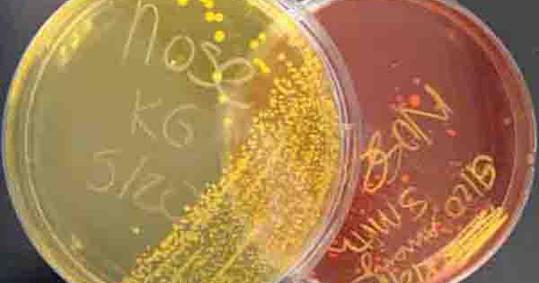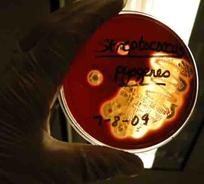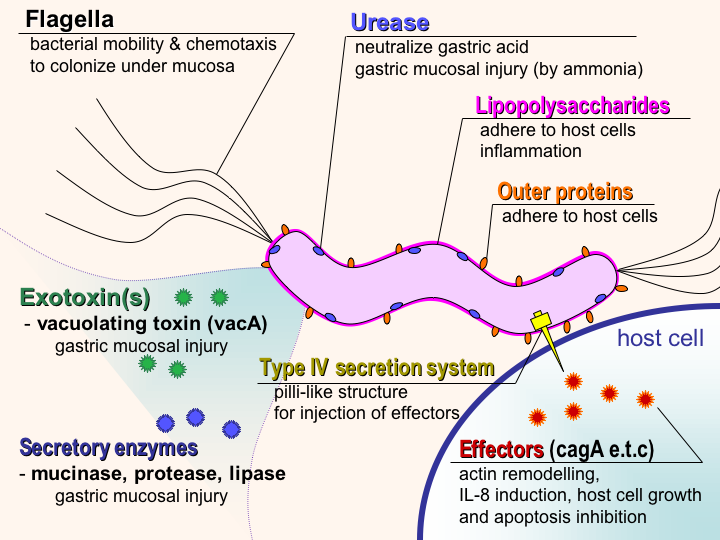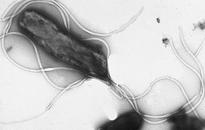 | ||||
What Are Normal Flora Microbes? - P3
Blood agar (BAP) inoculated with beta-hemolytic Streptococcus pyogenes, cause of strep throat and many other infections. Note the removal of red blood cells from the area of the medium where bacterial colonies of this pathogen is growing.
Page last updated: 3/2016
SPO VIRTUAL CLASSROOMS
PAGE 3 < Back to Page 2
However, S. epi is typically normal flora and the S. aureus is more pathogenic.
What makes a microbe a pathogen? Think of each little bacterium as having a tiny backpack that can be used to hold weapons called virulence factors. Virulence factors are features of a microbe that help it cause disease ... weapons.
Bacteria that do not often cause disease, such as normal flora, have fewer weapons in their "backpack" than do pathogens. The more pathogenic, typically the more weapons.
Mannitol salt bacterial growth medium contains a pH sensitive dye and the food item mannitol. S. epi can't eat mannitol. S. aureus does eat mannitol, and creates specific waste products from mannitol fermentation that trigger the medium to turn from pink to highlighter yellow.
Staphylococcus aureus:
S. aureus, the pathogen that has given rise to MRSA (Methicillin-resistant-Staphylococcus-aureus), has additional virulence factors, beyond just a slime layer. S aureus produces a number of enzymes such as coagulase that clots plasma and protects the bacterium. Another enzyme, hyaluronidase, helps the
Sources & Resources
- Bauman, R. (2014). Microbiology with Diseases by Taxonomy 4th ed., Pearson Benjamin Cummings.
- Bauman, R. (2004). Microbiology. Pearson Benjamin Cummings.
- Bacterial Growth Media & Culture Laboratory Exercise Main Page from the Virtual Microbiology Laboratory. In this lab students obtain clinical samples from their skin and mucous membranes and then plate the samples on various types of bacterial growth media.
- Introduction to Microbiology Lecture Main Page from SPO.
- Normal Flora Webpage, by Douglas F. Fix. Interactive page where you can select an area of the body and learn which normal flora typically colonize that location.
Helicobacter pylori, the bacterium that causes GI ulcers, has many weapons (virulence factors that help it thrive in the harsh environment of the stomach.
Staphylococcus:
All members of the genus Staphylococcus have a slime layer. The slime layer protects the bacteria from drying out on our salty skin, and helps the bacteria stick to things. A slime layer is like their "base model" defensive weapon.
Staphylococcus epidermidis:
S. epi bacteria is normally found on our skin and mucus membranes. Like all normal flora, it takes up space and resources, making difficult for other non-normal flora bacteria to grow. Because of their slime layer, and ability to form biofilms, S. epi can be problematic (opportunistic) when it begins to grow in layers on plastic internal medical devices. So the slime layer is a major virulence factor for Staphylococcus.
bacteria spread. And the enzyme beta-lactamase enables some S. aureus to resist some antibiotics. In addition to making a variety of enzyme virulence factors, strains of S. aureus also produces a number of toxins. A whole arsenal of weapons!
Identifying Pathogenic Staph
Mannitol Salt agar (MSA) is a specialized medium that distinguishes between normal flora Staph (S. epi) and pathogenic Staph (S. aureus). MSA is very salty, so only bacteria with a slime layer can grow on it.
Staphylococcus aureus biofilm (living film that slime layers help to make sticky) on an indwelling catheter.
What Make A Bacterium Pathogenic?
Staphylococcus epidermidis and Staphylococcus aureus are two species of bacteria both in the same genus, meaning that they are closely related.
 | ||||||
SPO is a FREE science education website. Donations are key in helping us provide this resource with fewer ads.
Please help!
(This donation link uses PayPal on a secure connection.)
Virtual Microbiology Classroom provides a wide range of free educational resources including PowerPoint Lectures, Study Guides, Review Questions and Practice Test Questions.






